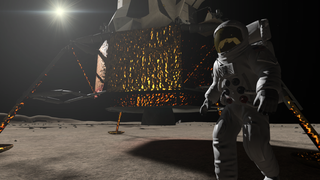Have you ever dreamed of going to the Moon? Imagined you were riding alongside Neil Armstrong and Buzz Aldrin as they piloted the lunar lander. Look around to see Earth out one window and stars lighting up black space from another.
Now Apollo 11 VR going to make your imagination real by enables users to relive the Apollo 11 mission and take some of the first steps on the Moon—though not the very first, because Neil Armstrong is a few feet ahead, kicking up lunar dust and proclaiming, “... one small step for a man, one giant leap for mankind.”
This all is going to done by Virtual technology.
The combination of a virtual reality environment and NASA data and media resources helped Immersive VR Education make its app a larger-than-life experience. It has received widespread critical and popular acclaim, including multiple awards, and has been purchased by more than 40,000 users.
NASA has an amazing trove of data about the Apollo lunar missions available online. This includes a pair of volunteer projects, the Apollo Flight Journal and the Apollo Lunar Surface Journal, hosted on NASA’s history website and among the most frequently used parts of the site.
Immersive VR Education CEO David Whelan said these repositories provided his company with extremely detailed design plans that illustrated the interiors of the spacecraft, the lander and the command module.
On NASA’s website, the team found a photo mosaic of the initial landing site created from many photos taken on earlier Apollo flights stitched together. The Immersive VR Education developers essentially drew their virtual world on top of that image.
“When players look out of the lander, they see every crater and every valley exactly as the astronauts would have seen them back in the day,” says Whelan, who said he was surprised by how much information was available.
“Everything is catalogued really well,” he says of the space agency’s websites. “I would have thought we’d have to contact NASA quite a lot more to get a lot of information that was actually freely available.”
Apollo 11 VR also includes original audio enhanced with music that makes the experience feel more momentous. “We find that if you get an emotional reaction from somebody, the experience sticks with them a lot more,” Whelan says.
Apollo 11 VR doesn’t just take users to the moon but recreates the entire mission, through atmospheric reentry and splashdown on Earth.
Not Just Fun and Games
Immersive VR Education is in the business of creating virtual classrooms. The company’s flagship product, Engage, lets up to 30 people participate in real time in a virtual lecture or meeting from anywhere in the world. Such events can then be posted online for later “experiencing.”The company built Apollo 11 VR to demonstrate a new way of teaching and learning history. “We’re trying to show the general public that virtual reality isn’t just for video games and entertainment,” Whelan says. “It’s also very useful for education.”



Comments
Post a Comment